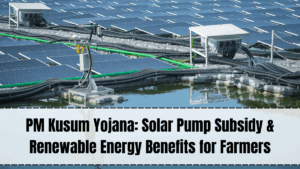The PM Kusum Yojana (Pradhan Mantri Kisan Urja Suraksha evam Utthaan Mahabhiyan) is one of the flagship schemes launched by the Government of India to promote renewable energy in agriculture. In 2025, the scheme continues to empower farmers by providing subsidies for solar pump installation, enabling them to irrigate fields without relying on costly diesel or grid electricity. This not only reduces farming expenses but also supports the country’s goal of increasing renewable energy capacity.

Objectives of PM Kusum Yojana Solar Pump Scheme
The scheme was designed to achieve multiple goals:
-
Energy Security for Farmers – Ensure a reliable and cost-free energy source for irrigation.
-
Promote Renewable Energy – Reduce dependency on fossil fuels and promote clean energy.
-
Increase Farmer Income – Allow farmers to sell surplus solar power to the grid for extra earnings.
-
Support Sustainable Agriculture – Encourage eco-friendly farming practices.
Components of PM Kusum Yojana
The scheme has three main components:
-
Component A – Decentralized grid-connected renewable energy power plants.
-
Component B – Standalone solar-powered agricultural pumps.
-
Component C – Solarization of existing grid-connected pumps.
For most farmers, Component B and Component C are the most relevant, as they directly provide subsidies for solar pump installation.
Subsidy Benefits in 2025
-
Individual Farmers: Up to 60% subsidy on solar pump costs.
-
State Government Contribution: Around 30%, with farmers paying only 10% of the total cost.
-
Capacity Range: Subsidy available for pumps between 2 HP and 10 HP.
-
Extra Benefits for Marginal Farmers: Special financial assistance and easy loan options.
Types of Pumps Covered
-
Surface Solar Pumps – Suitable for shallow water sources.
-
Submersible Solar Pumps – For deeper water tables.
-
Hybrid Solar Pumps – Can operate on both solar power and electricity.
Eligibility Criteria
To avail the benefits under PM Kusum Yojana Solar Pump 2025, applicants must:
-
Be a registered farmer in India.
-
Have agricultural land with an identified water source.
-
Not have availed subsidy for the same purpose before.
-
Provide all necessary documents for verification.
Required Documents
-
Aadhaar Card
-
Proof of land ownership or lease agreement
-
Recent passport-size photographs
-
Bank account details
-
Water source certificate
-
Quotation from approved vendor
Step-by-Step Application Process
-
Visit Official Portal: Go to your state’s renewable energy department or MNRE official website.
-
Register Online: Fill in personal, land, and irrigation details.
-
Choose Pump Type: Select the pump capacity and model.
-
Upload Documents: Submit scanned copies of all required documents.
-
Pay Contribution: Deposit your share (usually 10%) of the cost online.
-
Verification: Authorities verify your details and approve the request.
-
Installation: Vendor installs the solar pump within the given timeframe.
Key Benefits for Farmers
-
No Electricity Bills: Solar energy is free, reducing irrigation costs.
-
Extra Income: Farmers can sell excess power to the grid.
-
24/7 Water Supply: Independent from grid power availability.
-
Eco-Friendly Farming: Reduced CO₂ emissions.
-
Long-Term Savings: Pumps have a lifespan of 20–25 years with minimal maintenance.
Government Targets for 2025
The government aims to:
-
Install 20 lakh standalone solar pumps.
-
Solarize 15 lakh existing grid-connected pumps.
-
Achieve 30 GW renewable energy capacity through agricultural use.
Common Challenges and Solutions
-
Awareness Gap: Farmers may not be aware of the process – awareness camps and panchayat-level training are being conducted.
-
Initial Payment Burden: Loans with low interest rates are available through partner banks.
-
Technical Maintenance: AMC (Annual Maintenance Contracts) ensure smooth operation.
Expected Impact in 2025
The scheme is expected to:
-
Reduce diesel pump usage by 40%.
-
Cut annual carbon emissions by millions of tonnes.
-
Increase farm productivity due to reliable water supply.
FAQs
What is the farmer’s contribution under PM Kusum Yojana Solar Pump 2025?
Only about 10% of the total cost, with the rest covered by central and state subsidies.
Can I apply for the scheme offline?
Yes, applications can be submitted through designated government offices.
Are loans available for the remaining cost?
Yes, partner banks provide low-interest loans to cover the farmer’s share.
What is the maximum pump capacity eligible for subsidy?
Up to 10 HP solar pumps.
How long does installation take after approval?
Generally, between 30 to 60 days.
Click here to know more.
